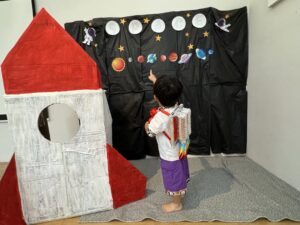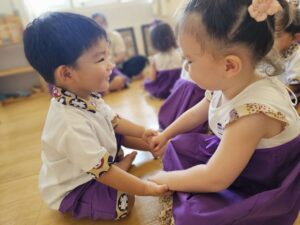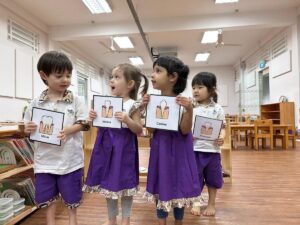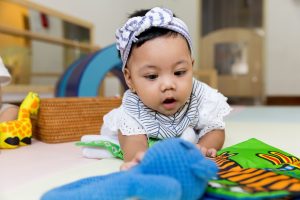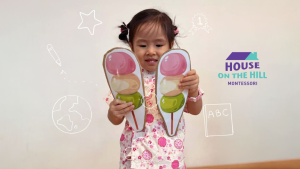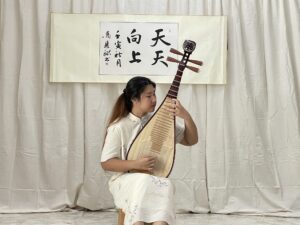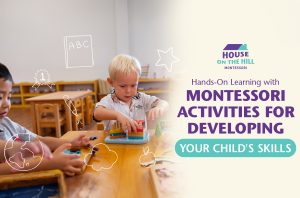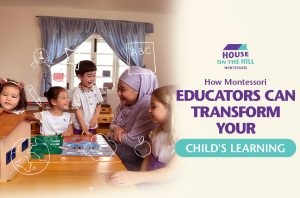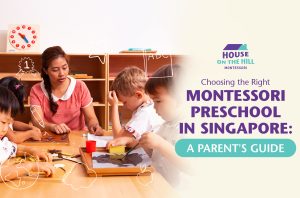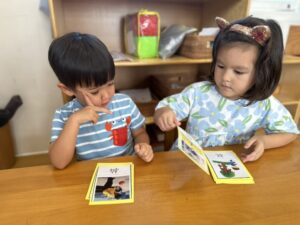
5 Tips for Parents Raising Bilingual Children
Supporting your child’s bilingual language journey at home and in school. In multicultural Singapore and an increasingly connected world, being bilingual is more than just a skill—it’s a doorway to opportunity. For children, growing up fluent in both Mandarin and English builds communication skills, fosters cultural appreciation, and helps them connect confidently with people from all walks of life. At House on the Hill, we’re committed to raising global citizens—curious, confident, and culturally aware. A key part of our Montessori approach is nurturing bilingual development from a young age. Our Mandarin Immersion Programme is thoughtfully woven into the Montessori curriculum, giving children a joyful, natural path to becoming bilingual. Why Early Childhood Is the Best Time to Learn Language From birth to age 7, children’s brains are naturally wired to absorb language. Here’s how their ability develops: At Birth: Babies can hear all 800+ sounds across world languages—perfectly primed to pick up any language. 6 to 9 Months: They tune into native language sounds (vowels by 6 months, consonants by 9 months).This is the ideal time to introduce a second language—early exposure helps extend this learning window. By 12 Months: Babies focus on the language(s) they hear most. Without ongoing exposure to two languages, they may lose the ability to tell them apart. Up to Age 7: Children can learn new languages well. Early, consistent exposure builds a lasting language foundation. 5 Practical Ways to Support Language Learning at Home 1. Create a Language-Rich Environment Children learn language through immersion. At House on the Hill, we expose children to Mandarin through songs, stories, conversations, and hands-on learning. You can do the same at home by: Playing songs and audiobooks in both English and Mandarin. Creating a book corner with simple storybooks in English and Mandarin. Displaying family photo captions in both English and Mandarin. Labelling household items in both languages. Even if you’re not fluent, showing enthusiasm and engaging with the language together signals to your child that both languages are valuable. 2. Establish Language Routines Children thrive on routine, and this applies to language learning too. You can try: To use a Three-Three System: 3 times a day, 3 days a week, over 3 weeks at a time to reinforce learning. To use Mandarin during bath time or mealtimes. To follow “one parent, one language” approach, if applicable in your home. At House on the Hill, Mandarin is woven into everyday routines, songs, and interactions—not treated as a separate subject. The same seamless integration can be mirrored at home. 3. Make It Playful and Purposeful Young children learn best through play. Language learning should be enjoyable, not pressured. Try: Singing Mandarin nursery rhymes together. Playing matching or “I Spy” games using Mandarin words. Using pretend play to practise vocabulary (shopkeeper, teacher, doctor). Talking in Mandarin while cooking, playing, or gardening. In our classrooms, children learn new words through real-life context and concrete experiences. Every interaction is a chance to build confidence and vocabulary. 4. Use Books as a Bridge Between Languages Reading aloud helps children grow their vocabulary and listening skills in both languages. At House on the Hill, we carefully curate books to support both English and Mandarin literacy. At home, you can try: Reading dual-language books together. Reading a story in English first, then again in Mandarin. Allowing your child to retell a story in the second language, even if it’s just key words or phrases. Recommended Reads: 7 Steps to Raising a Bilingual Child – Naomi Steiner Bilingual by Choice: Raising Kids in Two (or more!) Languages – Virginie Raguenaud. My First Mandarin Chinese Phrases – Jill Kalz Ming’s Adventure in the Forbidden City: A Story in English and Chinese – Li Jian Don’t worry if they don’t understand every word—repetition and exposure are what matter most. 5. Be Patient and Celebrate Little Wins Language learning takes time, and progress isn’t always linear. Children may mix languages (code-switch), favour one over the other, or go through silent periods. This is normal and part of the learning process. Mix languages (this is normal and shows skill!) Favour one language over another at different times Experience silent periods as they process new language Celebrate every milestone: a new word, a short phrase, or the courage to try. At House on the Hill, our teachers support each child with gentle encouragement—parents can do the same at home with patience and positivity. Activities by Age Group Below are some fun and effective ways to support your child’s language development at every stage: 0-6 Months | Sound Awareness and Exposure Talk and sing to your baby in both languages Play nursery rhymes or audio in the background Engage in face-to-face interactions—they love expressions 6–12 Months | Recognition and Response Use simple, repeated greetings like “Hello / 你好 / Selamat pagi” Narrate everyday routines (“Bath time!”, “Let’s go!”) Show simple picture books with labels in both languages 1–3 Years | Imitation and Early Speech Respond in your home language consistently Sing and move to action songs Play fun naming games and use flashcards Don’t worry if they mix languages—it’s a normal part of learning! 4–6 Years | Everyday Communication and Confidence Create daily routines for using your home language (e.g. bedtime stories) Try role-play games (shopkeeper, teacher, doctor) Watch cartoons or listen to audiobooks in both languages Set up playdates with peers who speak the same language Quick Tips for Parents More Exposure = Stronger SkillsFrequent use improves fluency, memory, and confidence. Quality MattersEngage with diverse sources: books, people, songs, and stories. Mixing Is NormalSwitching between languages shows flexibility—not confusion. Start Early, Stay ConsistentEarly exposure builds a stronger foundation. Make It FunLanguage grows best through joyful, everyday moments. Raising a multilingual child is one of the greatest gifts you can give them. It expands their thinking, deepens their cultural awareness, and opens doors for the future. With consistent support both at school and at home, your child will build the confidence to communicate and connect in two languages—and that’s something


